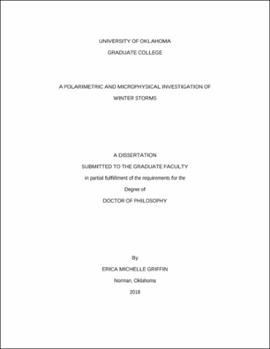| dc.contributor.advisor | Schuur, Terry | |
| dc.contributor.advisor | Chilson, Phillip | |
| dc.contributor.author | Griffin, Erica | |
| dc.date.accessioned | 2018-12-13T21:09:51Z | |
| dc.date.available | 2018-12-13T21:09:51Z | |
| dc.date.issued | 2018-12 | |
| dc.identifier.uri | https://hdl.handle.net/11244/316762 | |
| dc.description.abstract | The U.S. WSR-88D network has been upgraded to polarimetric capabilities, providing dual-polarization data for regions of the country never before sampled by polarimetric radar and allowing for an unprecedented view into the ice microphysical processes within winter precipitation. As the polarimetric data became available, a database was compiled, consisting of thousands of hours of polarimetric observations in a wide variety of winter precipitation events and exhibiting several intriguing and repetitive polarimetric signatures. Understanding what these polarimetric signatures reveal about different microphysical processes is crucial for improving their representation in numerical weather prediction models and quantitative precipitation estimation algorithms, as well as for better understanding precipitation formation and evolution throughout the depth of a cloud, ultimately improving winter weather forecasting.
This study first investigates the evolution and nature of intriguing and previously undocumented polarimetric signatures observed during the historic 8-9 February 2013 Northeast blizzard, and examines them in light of the thermodynamic environment within which they developed and the apparent microphysical processes that were active when they appeared. A more climatological and quantitative analysis is then conducted using a new quasi-vertical profile (QVP) methodology to investigate the microphysical evolution and significance of polarimetric signatures and their statistical correlations in the dendritic growth layer (DGL), at the tops of clouds, and near and within the melting layer (ML) in a selection of winter events. A statistical polarimetric model of the ML is introduced and a new method to estimate KDP in the ML is used to present the first reliable QVP statistics of KDP in the ML at S band. | en_US |
| dc.language | en_US | en_US |
| dc.subject | Polarimetric radar | en_US |
| dc.subject | Ice microphysics | en_US |
| dc.subject | Winter storms | en_US |
| dc.subject | Quasi-Vertical Profiles | en_US |
| dc.title | A Polarimetric and Microphysical Investigation of Winter Storms | en_US |
| dc.contributor.committeeMember | Biggerstaff, Michael | |
| dc.contributor.committeeMember | Zhang, Guifu | |
| dc.contributor.committeeMember | Engel, Michael | |
| dc.date.manuscript | 2018-12-12 | |
| dc.thesis.degree | Ph.D. | en_US |
| ou.group | College of Atmospheric and Geographic Sciences::School of Meteorology | en_US |
